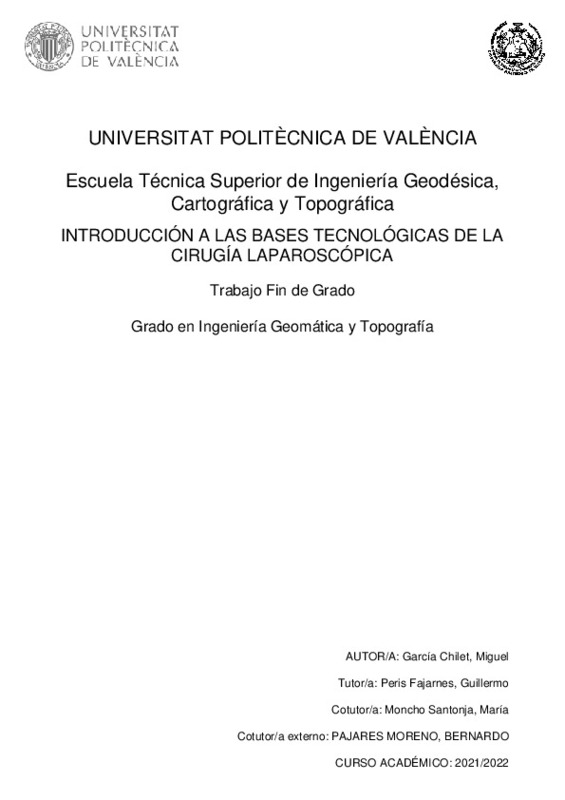|
Resumen:
|
[ES] La cirugía laparoscópica, es una intervención mínimamente invasiva (CMI), engloba varias
técnicas de observación directa del interior del cuerpo humano, para ello se utiliza
instrumental óptico que se introduce en ...[+]
[ES] La cirugía laparoscópica, es una intervención mínimamente invasiva (CMI), engloba varias
técnicas de observación directa del interior del cuerpo humano, para ello se utiliza
instrumental óptico que se introduce en algún orificio natural o temporal para permitir la
visualización del interior del órgano o cavidad. Desde los tiempos de Hipócrates, siglo V
a.C. se contemplaba la posibilidad de observar el interior del ser humano sin necesidad de
realizar una cirugía abierta, sin embargo no existía la tecnología que lo permitiese.
Este trabajo pretende, mediante una revisión bibliográfica, ser una introducción de las
bases tecnológicas en la cirugía exploratoria desde los inicios hasta su futuro, exponiendo
algunas de las actuales vías de investigación que mantienen relación con la ingeniería
geomática.
Para ello, se ha utilizado una extensa bibliografía formada por libros, artículos científicos,
estudios realizados por diversos autores, manuales de uso y buscadores científicos como
“Google Scholar”. De la información recopilada, se ha seleccionado aquella directamente
relacionada con el tema de estudio y su acercamiento a las ingenierías se ha valorado
positivamente, se ha utilizado la bibliografía más reciente siempre que ha sido posible.
La cirugía laparoscópica en este trabajo se divide en dos según el instrumental, la
laparoscopia convencional con uso de endoscopio y la laparoscopia asistida por robot.
Ambas presentan los mismos resultados quirúrgicos, sin embargo la cirugía asistida a pesar
de requerir de más tiempo y ser más difícil de dominar, presenta notables ventajes frente
el abordaje convencional, tanto para el paciente como para el equipo médico.
Como conclusiones de esta revisión destacamos, primero, actualmente estamos viviendo
una transición de la cirugía convencional hacia la cirugía asistida por robot, segundo, los
quirófanos se están convirtiendo en laboratorios de ingeniería y último, el futuro se
presenta favorable para la ingeniería, en el campo de la geomática especialmente,
responsable del control geométrico, captura y procesado de modelos 3D, así como de la
creación de herramientas que como el BIM en obra, permitan planificar y organizar los
servicios de atención médica.
[-]
[EN] Laparoscopic surgery, is a minimally invasive intervention, formed by several techniques
of direct observation of the human body’s interior, in the procedure, the optical instruments
are inserted into a natural or ...[+]
[EN] Laparoscopic surgery, is a minimally invasive intervention, formed by several techniques
of direct observation of the human body’s interior, in the procedure, the optical instruments
are inserted into a natural or temporary orifice to allow visualization of the interior of the
organ or cavity. From the time of Hippocrates, 5th century B.C. the possibility of observing
the interior of the human being without needing to perform open surgery was contemplated,
however, the technology that would allow it did not exist at that time.
This work intends, through a bibliographic review, to be an introduction to the
technological bases in exploratory surgery from the beginning to its future, exposing some
of the current lines of research that are related to geomatic engineering.
To do this, an extensive bibliography made up of books, scientific articles, studies carried
out by various authors, user manuals and scientific search engines such as "Google
Scholar" has been used. From the information collected, that directly related to the subject
of study has been selected and its approach to engineering has been valued, using the most
recent, whenever it was possible.
Laparoscopic surgery in this work is divided into two types according to the instruments
used, conventional laparoscopy with the use of an endoscope and robot-assisted
laparoscopy. Both present the same surgical results, however assisted surgery, despite
requiring more time and being more difficult to master, has notable advantages over the
conventional approach, both for the patient and for the medical team.
As conclusions of this review we highlight, first, we are currently experiencing a transition
from conventional surgery to robot-assisted surgery, second, surgery rooms are becoming
engineering laboratories and lastly, the future looks favorable for engineering, in the field
of geomatics especially, responsible for the geometric control, capture and processing of
3D models, as well as the creation of tools that, like the BIM on civil engineering, allow
planning and organizing medical care services.
[-]
|







